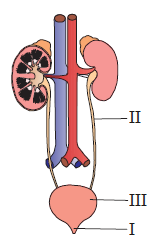Please refer to Excretory Products and Their Elimination Class 11 Biology Important Questions with solutions provided below. These questions and answers have been provided for Class 11 Biology based on the latest syllabus and examination guidelines issued by CBSE, NCERT, and KVS. Students should learn these problem solutions as it will help them to gain more marks in examinations. We have provided Important Questions for Class 11 Biology for all chapters in your book. These Board exam questions have been designed by expert teachers of Standard 11.
Class 11 Biology Important Questions Excretory Products and Their Elimination
Objective Questions
Question. Which of the following accessory excretory structure eliminates NaCl, lactic acid and urea?
(a) Kidney
(b) Liver
(c) Sebaceous gland
(d) Sweat gland
Answer
D
Question. Kidney helps in the conservation of useful materials and excretion of wastes and therefore they receive 20% of the heart’s output of blood (as much as the heart and brain combined). On a percentage basis which substance is most completely reabsorbed by the kidneys?
(a) Water
(b) Glucose
(c) Urea
(d) Sodium
Answer
B
Question. The part of the nephron impermeable to water is
(a) proximal tubule
(b) distal tubule
(c) ascending limb of Henle’s loop
(d) collecting duct
Answer
C
Question. Colloidal osmotic pressure in blood plasma is mainly due to
(a) albumin
(b) globulin
(c) fibrinogen
(d) sodium chloride
Answer
A
Question. Loop of Henle takes part in absorption of
(a) potassium
(b) glucose
(c) water
(d) urea
Answer
C
Question. Glomerular filtration rate (GFR) in a healthy individual is approximately
(a) 100 ml/minute, i.e., 180 liters per day.
(b) 125 ml/minute, i.e., 180 litres per day.
(c) 120 ml/minute, i.e., 100 litres per day.
(d) 130 ml/minute, i.e., 120 litres per day.
Answer
B
Question. A fall in glomerular filtration rate (GFR) activates
(a) adrenal cortex to release aldosterone.
(b) adrenal medulla to release adrenaline.
(c) juxta – glomerular cells to release renin.
(d) posterior pituitary to release vasopressin.
Answer
C
Question. Which region of the kidney nephron is the main site of amino acid reabsorption?
(a) Glomerulus
(b) Bowman’s capsule
(c) Proximal convoluted tubule
(d) Distal convoluted tubule
Answer
C
Question. Which of the following is directly responsible for increasing glomerular blood pressure and hence GFR?
(a) Aldosterone
(b) ANF
(c) Angiotensin II
(d) Renin
Answer
C
Question. The function of renin is
(a) degradation of angiotensinogen
(b) stimulation of corpus luteum
(c) to reduce blood pressure
(d) vasodilatation
Answer
A
Question. The hormone that promotes reabsorption of water from glomerular filtrate is
(a) oxytocin
(b) vasopressin
(c) calcitonin
(d) relaxin
Answer
B
Question. Which one is an important constituent of renin angiotensinogen-aldosterone system?
(a) JGA cell
(b) Macular cell
(c) Erythropoetin
(d) Plasma cell
Answer
A
Statement Type Questions
Question. Which of the following statement is correct?
(a) Vasa recta is not present in cortical nephrons.
(b) Maximum number of nephrons in kidney are juxtamedullary type.
(c) DCT of many nephrons open into collecting tubule.
(d) All of the above
Answer
A
Question. If Henle’s loop were absent from mammalian nephron which of the following event is to be expected ?
(a) There will be no urine formation.
(b) There will be hardly any change in the quality and quantity of urine formed.
(c) The urine will be more concentrated.
(d) The urine will be more dilute.
Answer
D
Question. Which one of the following statements in regard to the excretion by the human kidneys is correct?
(a) Ascending limb of Loop of Henle is impermeable to electrolytes.
(b) Descending limb of Loop of Henle is impermeable to water.
(c) Distal convoluted tubule is incapable of reabsorbing HCO3–.
(d) Nearly 99 per cent of the glomerular filtrate is reabsorbed by the renal tubules.
Answer
D
Question. Which of the following statement is correct regarding urine formation?
(a) Filtration and reabsorption takes place before secretion.
(b) Filtration and secretion takes place before reabsorption.
(c) Secretion takes place before reabsorption and filtration.
(d) Reabsorption takes place before filtration and secretion.
Answer
A
Question. Which of the following statements are correct?
(i) Glucose has high threshold value.
(ii) Urine is concentrated in Henle’s loop.
(iii) Haemodialyser removes urea, uric acid, glucose and proteins.
(iv) In glomerulus, urea, uric acid, water, glucose and plasma proteins are filtered out.
(a) (i), (iii) and (iv)
(b) (ii), (iii) and (iv)
(c) (i) and (ii)
(d) (i) and (iii)
Answer
A
Assertion/Reason Type Questions
In the following questions, a statement of Assertion is followed by a statement of Reason.
(a) If both Assertion and Reason are true and the Reason is the correct explanation of the Assertion.
(b) If both Assertion and Reason are true but the Reason is not the correct explanation of the Assertion.
(c) If Assertion is true but Reason is false.
(d) If both Assertion and Reason are false.
Question. Assertion : Aquatic animals like whales and seals are said to be ureotelic animals.
Reason : It is because of the fact that their main nitrogeneous waste product is urea.
Answer
A
Question. Assertion : In the descending limb of loop of Henle, the urine is hypertonic, whereas in ascending limb of loop of Henle, the urine is hypotonic.
Reason : Descending limb is impermeable to sodium, while ascending limb is impermeable to water.
Answer
A
Question. Assertion : Aldosterone is a steroid hormone and is important in the control of sodium and potassium ion concentration in mammals.
Reason : It upgrades sodium ion concentration in the ECF by promoting reabsorption of sodium ions from renal tubules and excretion of potassium ions in urine.
Answer
A
Diagram Type Questions
Question. Which is the correct order for the path taken by urine after it leaves the kidney?

(a) I → II → III
(b) III → I → II
(c) II → III → I
(d) II→ I →III
Answer
C
Directions : Refer the given diagrammatic representation of a nephron of human excretory system and answer the following questions.

Question. The label X represents ___________ that function in ______________.
(a) Vasa recta- Reabsorption of water, minerals and digestive end products.
(b) Henle’s loop- Filtration of plasma leaving the blood.
(c) Vasa recta- Filtration of plasma leaving the blood.
(d) Henle’s loop- Reabsorption of water, minerals and digestive end products.
Answer
A
Question. After the blood enters the kidney, it travels to the ____________.
(a) A
(b) B
(c) C
(d) D
Answer
A
Directions : Refer the given figure of nephron showing blood vessels and duct and answer the questions.

Question. Cells of which part is lined by simple cuboidal brush border epithelium that increases the surface area for reabsorption?
Identify the name also.
(a) 3, Descending limb of loop of Henle
(b) 5, Vasa recta
(c) 6, Proximal convoluted tubule
(d) 7, Collecting duct
Answer
C
Question. Which structures have an ability to produce the concentrated urine?
(a) 1, 2, 3
(b) 3, 4, 5
(c) 6, 7, 8
(d) 2, 4, 7
Answer
B
Critical Thinking Type Questions
Question. If excess water passes out from tissues without being restored by kidneys, the cells would
(a) burst open and die
(b) not be affected at all
(c) extract water from plasma
(d) shrivel and die
Answer
B
Question. In human beings the capsular urine entering the Proximal Convoluted Tubule (PCT) is
(a) isotonic to blood
(b) hypotonic to blood
(c) hypertonic to blood
(d) isotonic to sea water
Answer
A
Question. What will happen if the stretch receptors of the urinary bladder wall are totally removed?
(a) There will be no micturition
(b) Urine will not collect in the bladder
(c) Micturition will continue
(d) Urine will continue to collect normally in the bladder
Answer
D
Question. Excretion means
(a) removal of substances which have never been a part of body.
(b) removal of faecal matter from the body.
(c) removal of substances not required in the body.
(d) all of the above.
Answer
C
Question. Which one of the following correctly explains the function of a specific part of a human nephron ?
(a) Podocytes : Create minute spaces (slit pores) for the filtration of blood into the Bowman’s capsule.
(b) Henle’s loop : Most reabsorption of the major substances from the glomerular filtrate.
(c) Distal convoluted tubule : Reabsorption of K+ ions into the surrounding blood capillaries.
(d) Afferent arteriole : Carries the blood away from the glomerular towards renal vein.
Answer
A
Question. If the afferent arteriole that supplies blood to the glomerulus becomes dilated,
(a) the protein concentration of the filtrate decreases.
(b) hydrostatic pressure in the glomerulus decreases.
(c) the glomerular filtration rate increases.
(d) all of the above
Answer
C
Question. Under normal conditions which one is completely reabsorbed in the renal tubule?
(a) Salts
(b) Urea
(c) Glucose
(d) Uric acid
Answer
C
Question. A patient was diagnosed that one process of his excretory system was not functioning properly due to which his urine is not concentrating.
Identify the organ of the excretory system on which concentration of urine depends.
(a) Collecting duct
(b) Bowman’s capsule
(c) Length of loop of Henle
(d) Proximal convoluted tubules
Answer
C

